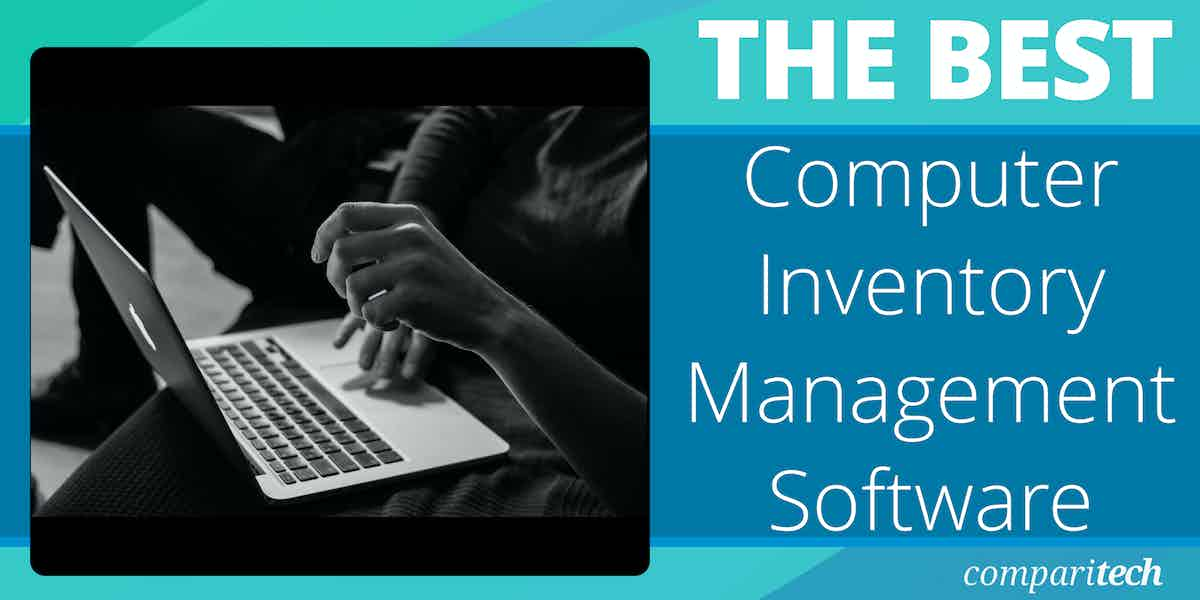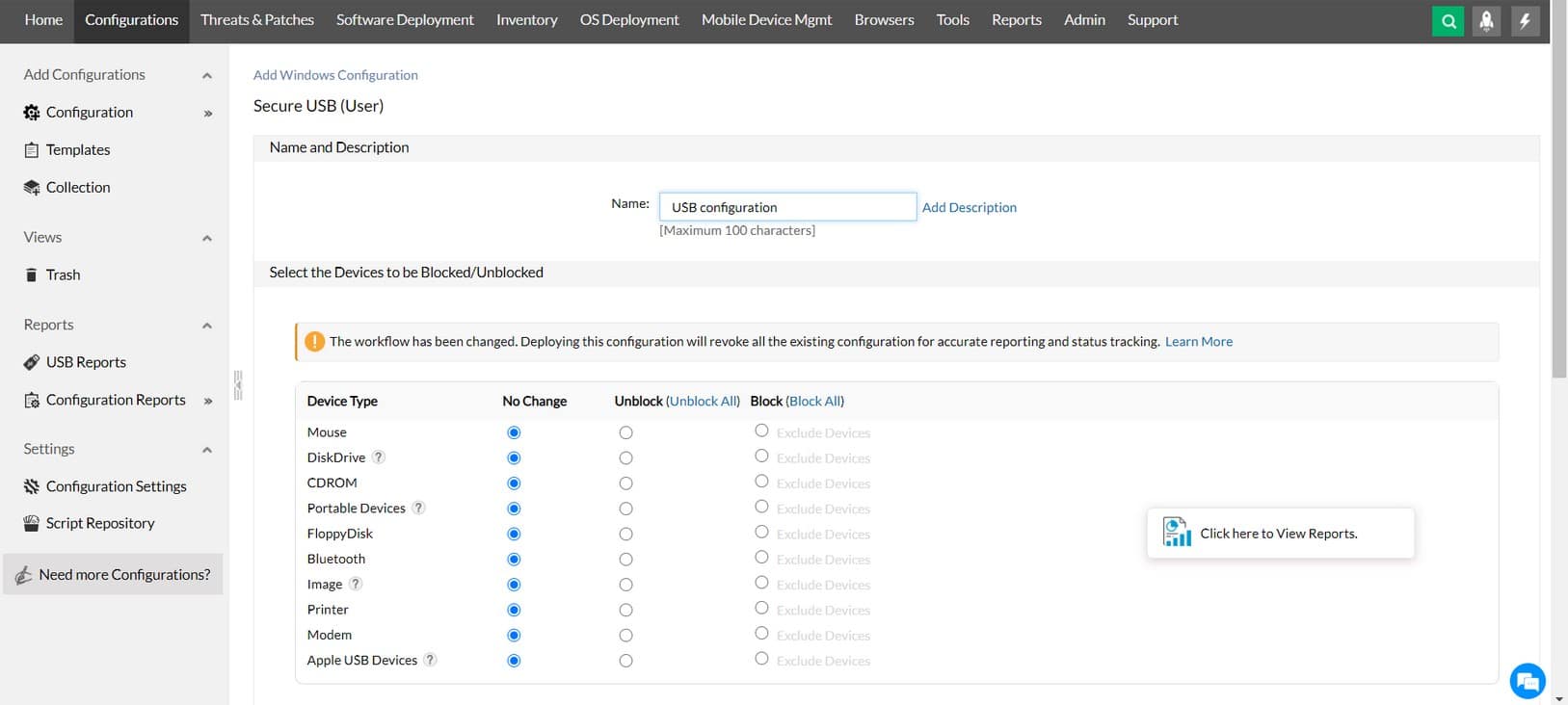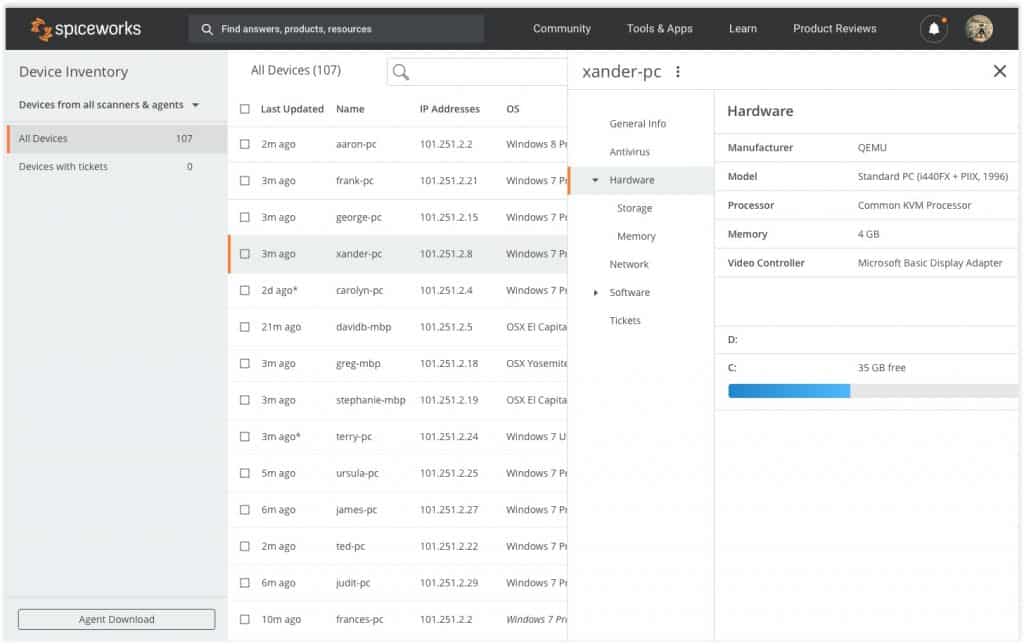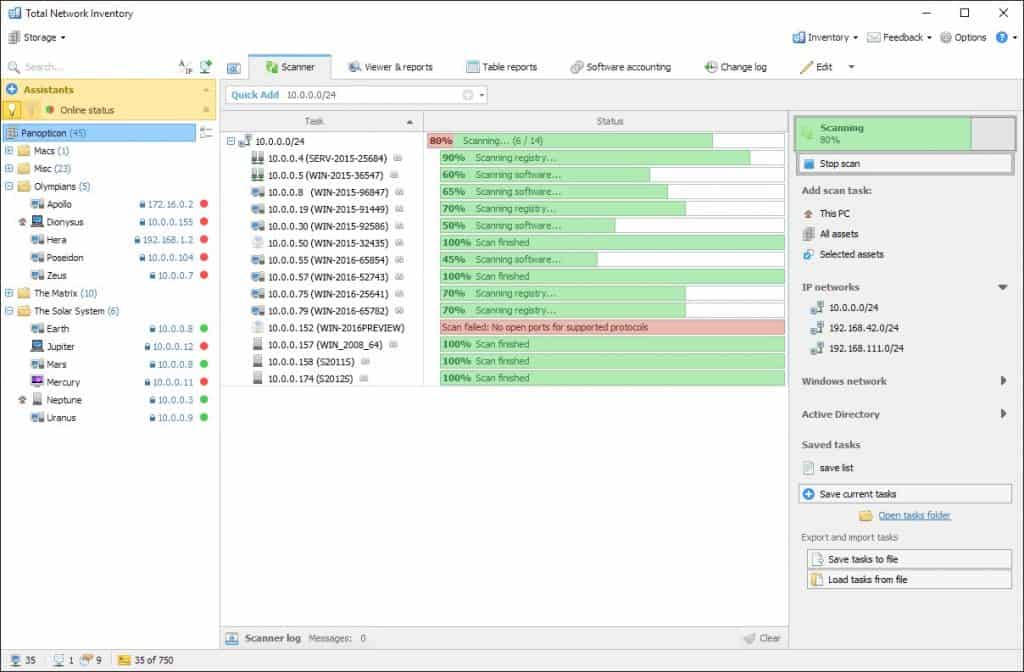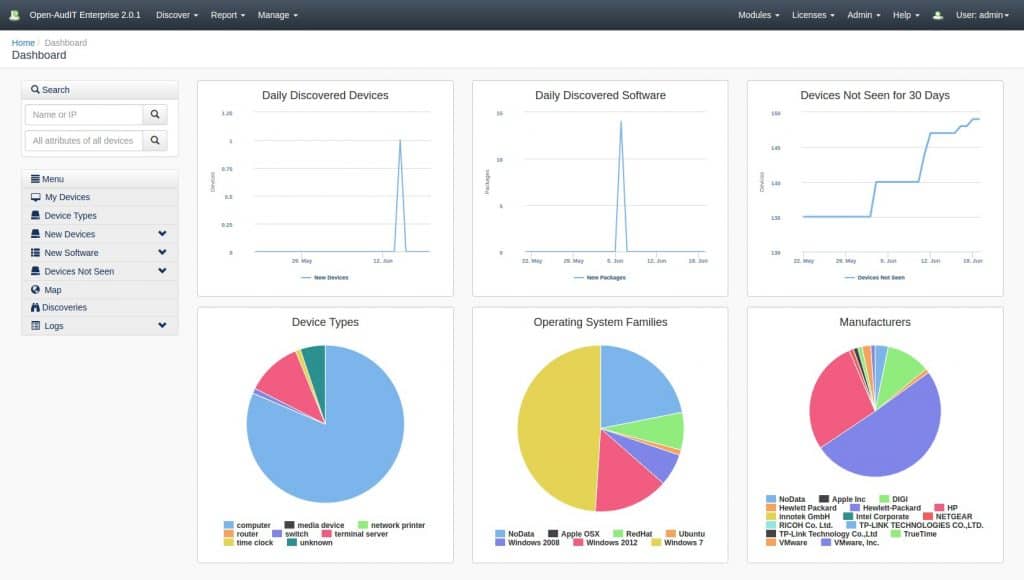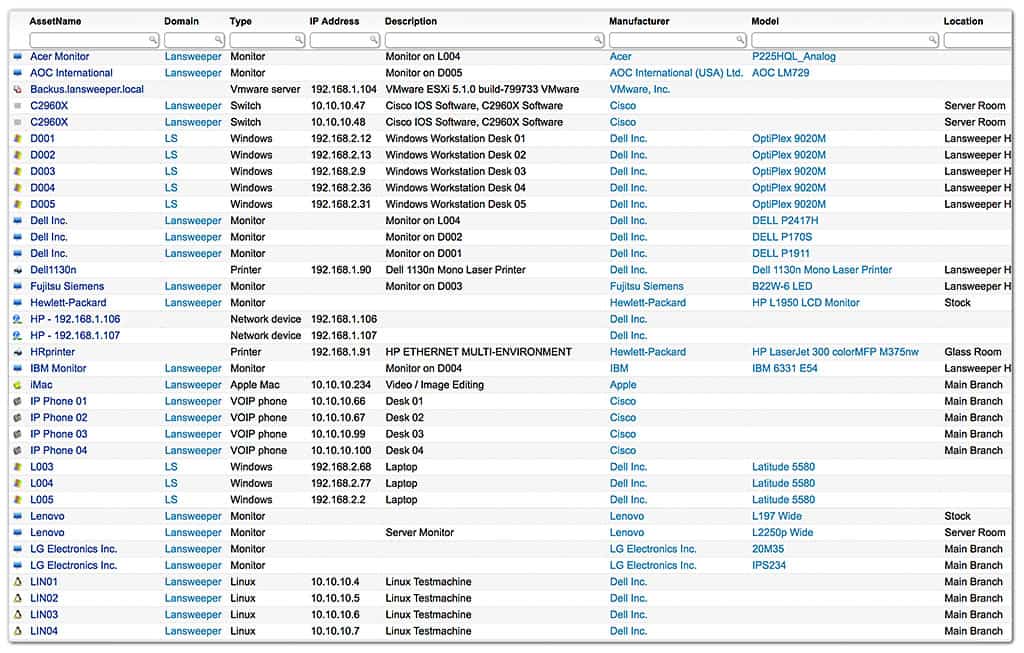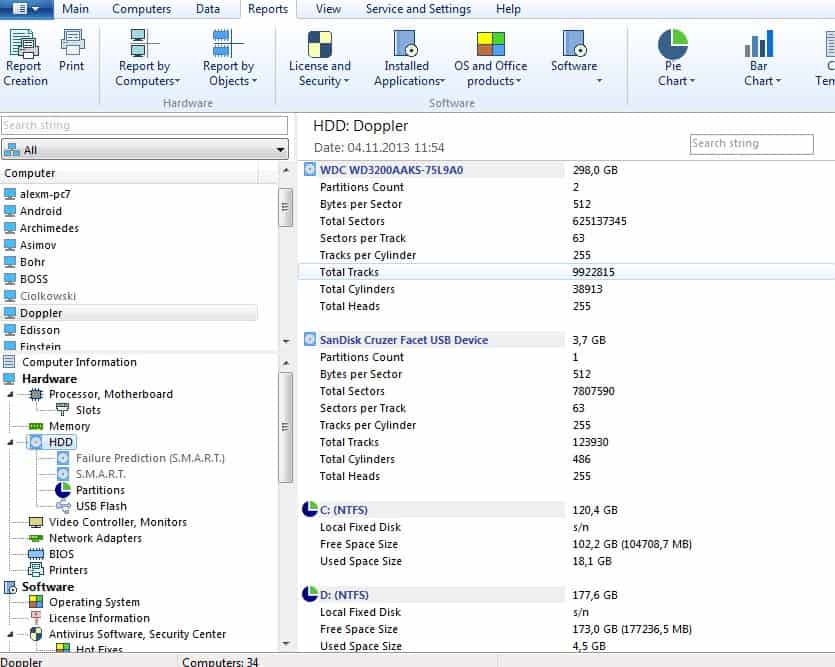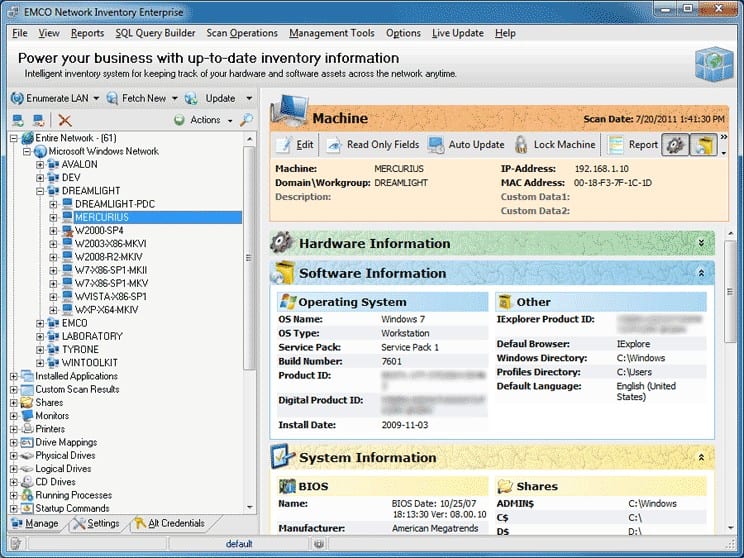Maintaining transparency over the devices in your network is the first step to securing them. Yet tracking hardware manually is easier said than done
Here is our list of the best computer inventory management software:
- ManageEngine Endpoint Central EDITOR’S CHOICE This endpoint management solution automates routine IT tasks like patch management, software deployment, and asset tracking. It enhances security, supports remote troubleshooting, and streamlines the management of servers, desktops, laptops, and mobile devices from a centralized platform. Available for Windows Server or as a SaaS platform. Start a 14-day free trial.
- JIRA Service Management Asset management software with automated asset discovery, configuration management, dependency mapping, and more.
- Spiceworks Inventory Free inventory management software with automatic IP range scanning, scheduled scans, reports, and more.
- Atera A SaaS package that is designed for use by managed service providers and includes a system inventory management service.
- Total Network Inventory Computer inventory management software with remote scanning, scheduled scans, configuration monitoring, and more.
- SolarWinds Server & Application Monitor Server and application monitoring solution with automatic IT asset discovery, monitoring dashboard, software inventory reports, and more.
- Open-AudIT Computer inventory management software that can monitor Windows and Linux PCs with automated scans, reports, and more.
- Lansweeper Network inventory software with IP range scanning, reports, alerts, automated warranty checks, and more.
- 10-Strike Network Inventory Explorer Network inventory monitoring software with automatic device scanning, hardware and inventory change tracking, health monitoring, and more.
- EMCO Network Inventory Network inventory management software with remote device discovery, customizable reports, an SQL query builder, and more.
Modern enterprises are leveraging more computer systems than ever before; it’s impossible to keep track unless you have an automated computer inventory management tool.
In this article, we will look at the best computer inventory management software on the market. The list includes a range of tools for Windows, macOS, and Linux. We’ve selected tools with autodiscovery features and configuration management functions that help you build a virtual monitoring environment.
The Best Computer Inventory Management Software
Our methodology for selecting a computer inventory management service
We reviewed the market for IT asset inventory management software and analyzed tools based on the following criteria:
- Automatic discovery of computers and other IT assets
- Maintenance functions, such as patch management
- Onboarding and standardization for settings and drivers
- Security protection to prevent tampering or unauthorized software
- Tools to access devices remotely for investigation and maintenance
- A free trial or a demo package that offers an opportunity for a cost-free assessment
- Value for money from a good set of tools at a fair price
With these selection criteria in mind, we identified a shortlist of tools to identify, log, and maintain computers on a company network.
You can read more about each of these solutions in the following sections.
1. ManageEngine Endpoint Central (FREE TRIAL)
ManageEngine Endpoint Central is an asset management system that tracks both hardware and software. The system can manage desktops, laptops, mobile devices, and removable storage devices.
Key Features:
- Designed for IT departments: Can manage multiple sites from a central location
- Logs all endpoints: Creates a hardware inventory
- Rechecks for new devices: Automatically detects changes to the fleet
- Multiple Endpoint Platforms: Manages devices running Windows, macOS, and Linux
- Mobile Device Management: iOS and Android devices
Why do we recommend it?
ManageEngine Endpoint Central is an asset management system for workstations and servers that can be running Windows, macOS, or Linux. A higher plan will also manage mobile devices running iOS and Android. This bundle creates hardware and software inventories and it includes automated performance monitoring with alerts. The management services in the system provide patch management and software license management. The system also provides technician tools for remote device access. The platform is available in versions to monitor a single site or a WAN.
The task automation services in the tool provide OS and configuration standardization and a library of software profile templates. With these two services, you can create an automated onboarding process that applies an OS image and then installs all of the software that has been allocated to a specific user group. The software management system extends to patch management that automatically polls for updates. You define maintenance windows in the management console and the service will queue patches for automatic installation at the next available window.
Who is it recommended for?
ManageEngine offers a Free edition that can monitor up to 25 endpoints. This is very appealing for small businesses who would find the full version too feature-rich and too expensive. The paid versions are ideal for mid-sized and large organizations and there is an edition available for managed service providers. The Endpoint Central package is available as software that runs on Windows Server or you can access the system as a SaaS platform. The cloud version means you can run a geographically dispersed technician team from one account.
Pros:
- Mass onboarding: Create device profiles and set up endpoints automatically
- Software inventory: Generates a list of software in use
- Software management: Licence management and patching
- Deployment Options: Available for on-site hosting or as a SaaS platform.
- Security Edition: Bundles in services such as Data Loss Prevention and Peripheral Device Control.
Cons:
- The Free edition is limited: Only manages 25 endpoints
ManageEngine Endpoint Central is offered for free to manage up to 25 devices. There are three paid plans and the upper two of these cover multiple sites. The service is offered as a SaaS platform but you can opt to download the software onto Windows Server. You can examine the Endpoint Central system with a 14-day free trial.
EDITOR'S CHOICE
ManageEngine Endpoint Central is our top pick for a computer inventory management software package because it simplifies endpoint management across diverse IT environments. It’s a comprehensive solution that goes beyond inventory tracking to provide a centralized platform for managing desktops, laptops, servers, and mobile devices. Real-time inventory management is one of the most important features of this package. It provides detailed insights into hardware and software assets. IT teams can easily track device specifications, installed software, license compliance, and usage patterns, reducing the risk of overspending or security vulnerabilities from unlicensed software. Endpoint Central’s ability to automatically discover and catalog assets ensures an up-to-date inventory without manual intervention. Security and compliance are at the forefront, with features like patch management and software license tracking ensuring your organization meets regulatory standards while reducing vulnerabilities. Its intuitive dashboards and customizable reports provide actionable insights, helping IT teams make informed decisions on asset utilization and lifecycle management. Endpoint Central is also scalable, supporting businesses of all sizes with flexible deployment options, including on-premises and cloud-based models. It integrates seamlessly with other ManageEngine tools, making it a versatile choice for organizations with existing solutions. The software’s remote management capabilities allow IT teams to troubleshoot and manage endpoints regardless of location, a vital feature in today’s hybrid work environments.
Download: Start 14-day FREE Trial
Official Site: https://www.manageengine.com/products/desktop-central/free-trial.html
OS: Windows, Cloud-based
2. JIRA Service Management

JIRA Service Management is an asset management solution that can discover devices throughout your network and add them to a central repository. Discovered systems automatically have their status updated. You can view them through the dashboard, highlighting information such as the Serial Number, Owner, Status, Model, Location, and Warranty expiration date of assets.
Key Features:
- Asset discovery: Scans the network and creates a hardware inventory
- Software management: Maintains a software inventory for license management
- External data sources: Import data from third-party tools to coordinate information
Why do we recommend it?
JIRA Service Management provides Service Desk functions that locate and track assets, including endpoints and network devices. The discovery function compiles an asset inventory, which details the attributes of each computer and piece of equipment. This system is a management console for asset issues. It takes feeds from other tools, such as system monitors that generate alerts. The package then renewables investigation of the problem to be prioritized and assigned to a technician for investigation or resolution.
The platform also includes a range of configuration management features. For instance, it can automatically add items to a configuration management database and detect configuration changes. It can also display dependencies between configuration items or assets and services.
JIRA Service Management provides users with alerts that notify them about the device regarding incident response capabilities. Users can configure escalation policies to ensure that urgent alerts are handled in a timely fashion. Reporting and analytics features allow you to monitor incident response activities and ensure there are no gaps.
Who is it recommended for?
JIRA is a package for large organizations. It isn’t a Help Desk system and doesn’t include a ticketing package. So, if you want to combine asset tracking and user support with one team management system, this isn’t the package for you. The JIRA Server Management is a SaaS package, so you don’t need to host any software on your own servers to use the service.
Pros:
- Part of a wider tool: Service Desk includes problem and change management
- Lifecycle management: Identify device age and plan for replacement
- User support: Help users understand how to properly use company IT assets
Cons:
- Limited Free plan: The Free edition only allows three agents/technicians
JIRA Service Management is ideal for enterprises that want to create asset inventories within a solution that includes incident management capabilities. Free plan available with up to 3 agents and 2GB of storage. The Data Center version starts at $17,200 (£12,185) per year for 50 agents. You can begin the 7-day free trial from this link here.
3. Spiceworks Inventory
Spiceworks Inventory is a free inventory management tool that can automatically discover devices connected to your network. With Spiceworks Inventory, you can add an IP range to scan and start finding all assets within that range. You can also schedule scans by group and scan devices every five minutes.
Key Features:
- Online tool: Create a free account for access
- Requires an agent program: The dashboard downloads that for you
- Scans the network: Creates a hardware inventory
Why do we recommend it?
Spiceworks Inventory is a good solution for small businesses because it is lightweight, hosted, and free to use. This system reaches out to your network through the installation of an agent – there are agents available for Windows and macOS. It then discovers all devices and creates a hardware inventory. The system is also able to scan endpoints for software if that endpoint has an agent installed on it, so, for the best results, you need to install a collection agent on each computer on your network.
After discovering devices, you can automatically update the installed software, view info on the device manufacturer, MAC address, installed software, open ports, and more. This provides you with a basic overview of your environment to take inventory of your environment and identify vulnerabilities.
Reports provide you with critical information on connected devices. For instance, you can create a report that shows devices that don’t have an antivirus installed. These reports can be scheduled to be regularly sent to your email, giving you periodic updates about the status of connected systems.
Who is it recommended for?
This tool is good for small businesses. It is even good for businesses that run an in-house Help Desk because the online platform provides a Help Desk ticketing system that can be linked into the Inventory module. Although the tool discovers all of the devices that are connected to the same network that the Spacework agent host is on, the device details that the inventory management service isn’t great for devices that don’t have an agent. As the agent is only available for Windows and macOS, you won’t get any details for computers running Linux, mobile devices, or network equipment.
Pros:
- Software inventory option: Install an agent on each endpoint to get a software scan
- On-demand scanning: Updates the inventory on demand
- Completely free to use: There is no paid version
Cons:
- Suitable for small businesses: On-demand data refresh isn’t feasible for large companies
Spiceworks Inventory is an excellent choice for enterprises that need a low-cost solution for creating an IT asset inventory. It is an online system but you need to install an agent on at least one device on your network. Install a collector on each device to get more details than just that node’s make and IP address. Unfortunately, the agent/collector is only available for Windows and macOS. The software is entirely free and supports unlimited devices, agents, and users. You can sign up for the tool from this link here.
4. Atera

Atera is a cloud-based platform that includes a package of tools for the remote monitoring and management of client systems. An inventory of equipment on each client site lies at the heart of this monitoring service and so it helps your technicians to keep track of the computer inventory on each site.
Key Features:
- A remote monitoring and management package: Provides tools for IT support technicians
- Creates a hardware inventory: Lists all network devices and endpoints
- Compiles a software inventory: Implements license management and patching
- Versions for IT departments and managed service providers: Each type of user has different needs
Why do we recommend it?
Atera is designed to perform remote monitoring and management of IT assets. The package is able to monitor multiple sites simultaneously and there is also an edition for managed service providers that is multi-tenanted, keeping the data of each client separate. Each MSP client could also be operating multiple sites that need to be monitored. The tool scans each enrolled network and compiles an inventory that covers network devices and endpoints. This list of assets is stored as both hardware and software inventories. The software inventory forms the basis for license management and patch management. The asset monitoring service in the package performs constant status checks on network devices and endpoints, looking for resource exhaustion or component failure.
The computer inventory services of Atera can be enhanced by an add-on service that performs automated network mapping, keeping track of the connections between all computers and network devices.

Who is it recommended for?
Atera is designed for IT departments and for managed service providers. This is a cloud-based subscription system, so your technicians can access the console from anywhere through any standard Web browser – even from home. The rate for the package is set per technician per month so just a single subscriber gets all of the functions that large businesses enjoy. Thus, the Atera system is particularly advantageous for independent support specialists and small managed service providers.
Pros:
- Automated monitoring: Full stack observability
- Remote access: Use Splashtop or Anydesk for support or maintenance
- Automated patch manager: Triggered by the software inventory
- Automated maintenance routines: The patch manager includes a task scheduler
Cons:
- Network discovery is an add-on: Requires an extra payment
As Atera is a cloud-based service, its console can be accessed through any standard browser and it is even possible to group together technicians located at several sites or from their homes. The system is offered in three plans that all also include team and business management tools. There are integrations available for Atera that enable the system to interact with third-party tools, expanding your system monitoring toolset. You can assess Atera with a free trial.
5. Total Network Inventory
Total Network Inventory is a computer inventory management tool that allows you to monitor devices in real-time. With Network Inventory Advisor, you can remote scan Windows, Unix, VMware, and SNMP-based systems to build your monitoring environment. Once devices are connected, you can collect information from them, such as the type of software they have installed.
Key Features:
- Scans a network: Runs through Active Directory or an IP scanner
- Hardware inventory: Logs all endpoints and network devices
- Creates a software inventory: Provides software license management
Why do we recommend it?
Total Network Inventory is a system discovery and monitoring tool that will create hardware and software inventory for your network. It can identify computers running Windows, Linux, macOS, and Unix. The tool then provides continuous availability and status monitoring of all devices through the use of the Simple Network Management Protocol (SNMP). The system creates a changelog for hardware and software and it also provides software license management in its highest plan. That upper plan, which is called Total Network Inventory Professional will also create a network topology map. The system is able to scan local networks and also remote networks.
You can monitor the hardware and software changes of all connected devices. The software does this by creating configuration snapshots of devices with each scan, comparing the results against past scans, and listing everything that was added, changed, or removed.
Scheduling scans enable you to determine how regularly the system will discover new devices. You can also create a topology map of your network by drag-and-drop. Simply add assets to a canvas view and create a map that highlights your entire network. There is also a notification system that notifies you about asset and software issues.
Who is it recommended for?
Total Network Inventory is ideal for use by small businesses. However, the company reports that it serves some very large businesses, including IBM, Disney, and NASA. The system is an on-premises package that runs on Windows and Windows Server. It will run network scans on demand or it can be set up to perform a sweep regularly on a schedule.
Pros:
- Runs on an endpoint: Doesn’t require a powerful server to host
- Stores data in files: Creates a directory with a file containing details of each device
- License usage count: Summarizes installation per package
Cons:
- Stronger at software management: Doesn’t have many hardware management features
Total Network Inventory is a reliable solution for SMEs looking for a low-cost and straightforward inventory management platform. It is available on Windows. Prices start at $90 (£63.77) for 25 nodes. You can start the 60-day free trial from this link here.
6. SolarWinds Server & Application Monitor
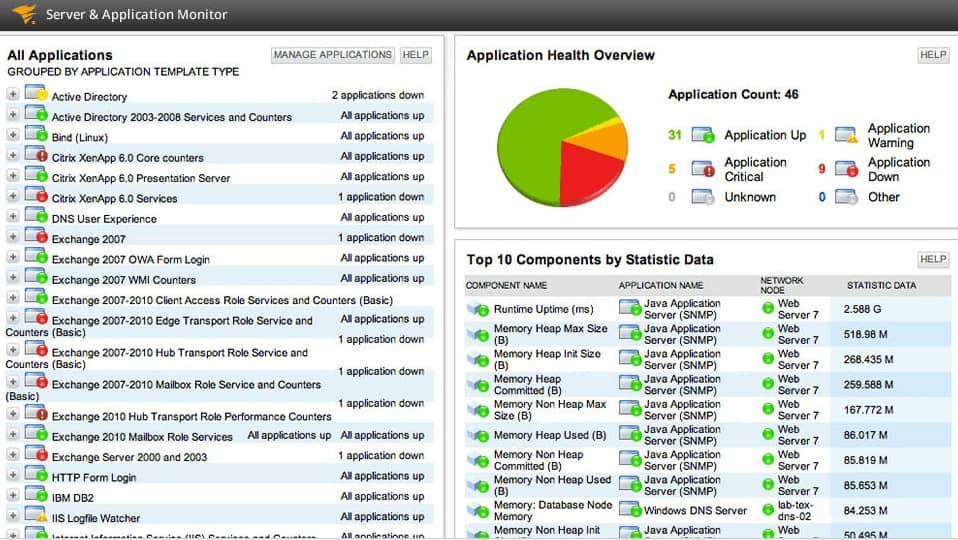
SolarWinds Server & Application Monitor is a server and application monitoring solution that provides automated inventory management. With SolarWinds Server & Application Monitor, you can automatically discover IT assets and monitor over 1200 vendors, applications, servers, and databases from a web-based GUI.
Key Features:
- Asset discovery: Creates an endpoint and software inventory
- Service tracking: Records server resource capacity and utilization
- Alerts for performance issues: These appear in the dashboard
Why do we recommend it?
SolarWinds Server and Application Monitor is a thorough asset documentation system, listing servers and the software packages that they host. This tool keeps a constant check on server performance, watching the key metrics of activity, such as disk space, CPU, memory, and network interfaces. In each case, the tool measures utilization against the known capacity of that resource. The package provides alerts if any resource runs short. The monitor tracks software interactions between packages, with services, and with server resources. This application dependency map enables the tool to quickly identify the root cause of performance impairment.
Through the dashboard, you can monitor recent configuration changes and see newly added or removed hardware. This enables you to monitor changes in your environment. There are also software inventory reports that detail current infrastructure updates, admins who installed the updates, resources used, unused hardware, and more.
The platform also comes with application infrastructure dependency mapping that enables you to see a visual display of application dependencies and issues throughout your environment.
Who is it recommended for?
This tool is a cost saver because it enables technicians to get on with other tasks and leave the automated monitoring tool to watch over servers and applications. So, this is a lot more than an inventory management software package because it also provides performance monitoring. The system is ideal for large businesses that run many on-premises servers, each hosting many software packages. Mid-sized businesses would also benefit from using this package, however, it probably provides a lot more inventory monitoring and management functions than a small business would need.
Pros:
- On-premises software: Runs on Windows Server
- Correlates activity: Links application requirements to server resource availability
- Cloud monitoring: Tracks the performance of services on AWS and Azure
Cons:
- Not available for Linux: Will only install on Windows Server
SolarWinds Server & Application Monitor is a great choice for enterprises looking for an automated inventory management tool with a wide range of monitoring capabilities. It is available on Windows. Pricing starts at $1,813 (£1,377). You can download a free 30-day trial.
7. Open-AudIT
Open-AudIT is an inventory management software that enables users to query Windows and Linux PCs from a web-based user interface. Information you can view includes hardware, software, OS settings, security settings, users, groups, IP address, MAC address, open ports, and more. This information is available in PDF, CSV, web page format, or via export by Dia and Inkscape.
Key Features:
- Free to use: The tool is run for free by Opmantek, which markets its own system for sale
- On-demand scanner: Launch the scan manually
- Scheduled scanning: On a daily basis
Why do we recommend it?
Open-AudIT is a network discovery and asset management tool. The system is available as an on-premises package for Windows and Windows Server and there is also a SaaS version. Free stuff is great but there is a catch with Open-Audit because it won’t run on Windows 2016 or any version of Windows Server after 2016. This system will create hardware and software inventories and it will also provide a software license manager. The paid versions give you network mapping and the top edition, including its cloud counterpart, provides file integrity monitoring and cloud services discovery.
The platform enables you to schedule daily automatic scans to keep your environment updated and ensure that the software identifies newly added devices. Choose from over 50 out-of-the-box reports to generate summaries on operating system type, device type, manufacturers, MS office, installs, disk usage, and more.
Paid versions Open-AudIT, such as the Opmantek Professional, Opmantek Enterprise, and Opmantek Cloud versions, provide additional features like network analysis dashboards, geographical maps, and enhanced visual reporting that the community version lacks.
Who is it recommended for?
Open-AudIT is an appealing proposition for small businesses, except there probably aren’t many companies that haven’t upgraded to Windows 10 yet, so there won’t be many SMBs that will be able to run this free package. The company has some very large businesses on its client list, including Microsoft and Cisco Systems, so big businesses should consider the Open-AudIT system. The cloud version makes the Open-AudIT system available for businesses that don’t have any Windows computers to load the software onto – that option also relieves you of the task of maintaining the software.
Pros:
- Cross-platform: Available for Windows or Linux
- Creates a hardware inventory: Lists endpoints and network devices
- Records Network settings: Details addresses and port details
Cons:
- Only runs on Windows before Windows 10: Not available for Windows 10 or 11
Open-AudIT is a useful tool for smaller enterprises that want a tool to gather information on Windows and Linux systems. It is available for Windows and Linux. Please note this platform isn’t compatible with Windows 10. You can download the for free from this link here.
8. Lansweeper
Lansweeper is a network inventory software that can IP range scan your network to discover connected devices and sort them into categories based on device type. Users can search through discovered devices by IP and filtered searches so they can quickly detailed Critical gather information on the infrastructure they’re looking for.
Key Features:
- Asset discovery: Creates a hardware inventory
- Endpoint scanning: Compiles a software inventory
- Scans Active Directory: Provides a user count
Why do we recommend it?
Lansweeper is a nice network scanner that is ideal for small businesses in its free version. The paid version starts at a price for a minimum of 20,000 assets, which is a lot and so pushes its audience up into the market of large organizations – mid-sized businesses would get a better deal from many of the other tools on this list. As well as discovering devices on-premises, the tool can identify cloud assets. It then compiles an inventory for all of the systems that it encounters. Extras in the top plans include vulnerability scanning and asset lifecycle management.
The platform comes with over 400 out-of-the-box reports that you can use to collect specific information from your environment. For example, you can create reports that detail all devices that are out of warranty or highlight unauthorized administrators. You can also create custom reports if you’re looking for other information.
Automated warranty checks are another helpful feature that comes with Lansweeper. These checks automatically scan devices and retrieve warranty details from the vendor’s websites and then issue you email alerts to notify you when a warranty is about to expire.
Who is it recommended for?
The free version is a good option for small businesses. The paid tool’s minimum asset count will be off-putting for most other businesses. Large companies would probably be more interested in a full Service Desk package rather than a standalone inventory system such as Lansweeper.
Pros:
- Sortable and searchable device list: Specify the order for the inventory list
- Hardware details: Make, model, and device type
- Security features: Spot rogue devices and evaluate the configurations of valid network devices
Cons:
- Limited Free edition: The Free edition doesn’t include OT discovery
Lansweeper is an excellent solution for enterprises that require a free computer inventory management tool. It is available for Windows. Free and paid versions available. The free version supports up to 100 assets. The Starter plan version costs $2,408 (£2,000) per year. You can download the free trial from this link here.
9. 10-Strike Network Inventory Explorer
10-Strike Network Inventory Explorer is a network inventory monitor that automatically scans for devices throughout your network so you can monitor them. 10-Strike Network Inventory Explorer allows you to collect installed hardware, hardware changes, software changes, and more.
Key Features:
- PC discovery: Documents all devices on the network
- Software management: Scans endpoints and logs all its software
- Change detection: Continuous scanning spots changes and additions to hardware and software
Why do we recommend it?
10-Strike Network Inventory Explorer offers device discovery and inventory creation, detailing endpoints, running Windows, Linux, and MacOS it can also include Android devices if they are manually enrolled in the scanning program. When the system encounters a computer, it scans the device for all of its installed software and notes its operating system. This leads to the creation of a software inventory, which can be used for license management. Hardware discovery also scans each device for status reports, such as resource availability and component performance.
The tool comes with a range of health monitoring capabilities that allow you to remotely read S.M.A.R.T parameters of connected computers, monitor disk health and temperature. You can use these parameters to find performance issues and then create reports to gather further information about the problem.
Who is it recommended for?
This is a good package for small and mid-sized enterprises. The continuous scans provide a system monitoring services along with inventory management functions. This means that it offers two functions for the price of one. The software is sold on a perpetual license with a price that is dictated by the number of devices that need to be tracked. This system runs on Windows and Windows Server.
Pros:
- Security use: Spots rogue devices connected to the network and unauthorized software on endpoints
- Alerting: Set up the system to raise an alert if it detects changes in hardware or software inventories
- Hard drive health monitoring: Covers temperature and disk space availability plus whether antivirus software licenses are about to expire
Cons:
- Windows only: Will scan endpoints running Linux and macOS but can’t be installed on them
10-Strike Network Inventory Explorer is a good starting point for enterprises looking to monitor a smaller network environment. It is available on Windows. Pricing for the standard version starts at $79.95 (£56.65) and supports up to 25 computers. You can start the 30-day free trial from this link here.
10. EMCO Network Inventory
EMCO Network Inventory is a network inventory management tool that can remotely detect devices throughout your environment and provide you with an inventory summary. This summary includes OS name, OS type, service pack, build number, product ID, digital product ID, and install date of devices.
Key Features:
- Endpoint discovery: Creates a database of computer details
- Asset tracking: Maintains both hardware and software inventories
- Software license management: Prevents too many copies being installed
Why do we recommend it?
EMCO Network Inventory is a competent device inventory creator that has a search tool in it that can create queries with SQL. The queries help you locate specific devices in the inventory or filter records to produce your own reports. This is a useful service that details the operating system of each of the computers that it encounters. It also scans each computer for all of the software installed on it. The inventory shows that list per device, but you can also use SQL queries to gain enterprise-wide summaries, which is useful for license management.
An SQL query builder gives you the ability to run custom queries to find particular device data. Key systems data can be exported in Excel, PDF, XML, and other formats so that you can share information easily with the rest of your team/
Generate custom reports to highlight particular data points on devices. For instance, you can create a license report that allows you to compare the number of licenses you own against unused licenses. You can also create a report that lists the applications installed on a particular device.
Who is it recommended for?
This is a tool that SMBs would enjoy using and it is very affordable. The system doesn’t offer any monitoring services, which puts it at a disadvantage when compared to 10-Strike Network Inventory Explorer. Although this EMCO Network Inventory seems a little lightweight for use by large organizations, EMCO offers licenses to scan more than 1,000 devices and it counts Westinghouse, the US Army, and Pepsi among its clients.
Pros:
- Searchable database: Create SQL queries for complex analysis
- Details the attributes of endpoints: Details on configurations and peripheral devices
- Inventory reports: A reporting engine that enables users to create their own report formats
Cons:
- Windows PCs only: Only lists Windows PCs
EMCO Network Inventory is suitable for enterprises that require an affordable and effective computer inventory management solution. It is available on Windows. Prices start at $149 (£105.57) for the Professional Edition, which supports up to 25 nodes. You can start the 30-day free trial via this link here.
Choosing Computer Inventory Management Software
Tools like ManageEngine Endpoint Central provide a hassle-free inventory management experience you can use to monitor configurations easily.
However, suppose you want a lower-cost tool with more limited features. In that case, an alternative like Spiceworks Network Inventory with network autodiscovery is a good choice because it’s reliable and free. That being said, we recommend trying out multiple tools before you decide to buy to make sure that you discover the solution that’s right for your environment.
Computer inventory management FAQs
What is computer inventory management?
Computer inventory management is a strategy that records a list of computers owned by a business and identifies attributes of each, such as make, model, and operating system version. The asset inventory is the central document store for inventory management and needs to be kept constantly up to date. Software inventories are also considered to be part of computer inventory management.
How do you digitize inventory?
Maintaining an IT asset inventory on computer has many advantages over paper-based systems. Computerized records take up less space than files and they are easier to sort through. Records held in a computer are less likely to get mislaid, damaged, or lost, particularly if the system is backed up. Computerized inventory management systems can be linked to system scanners that will automatically update records to keep them current.
What is the difference between hardware inventory and software inventory?
A hardware inventory lists each physical computer on a network and details the attributes of each. The operating system version is usually also listed as part of the hardware inventory. The software inventory lists all of the software installed on each computer – that includes the operating system again. A software inventory is useful for license management because it can summarize the number of each package that is installed within the business. It also supports patch management systems.

